2014 MITSUBISHI LANCER SPORTBACK child lock
[x] Cancel search: child lockPage 49 of 422
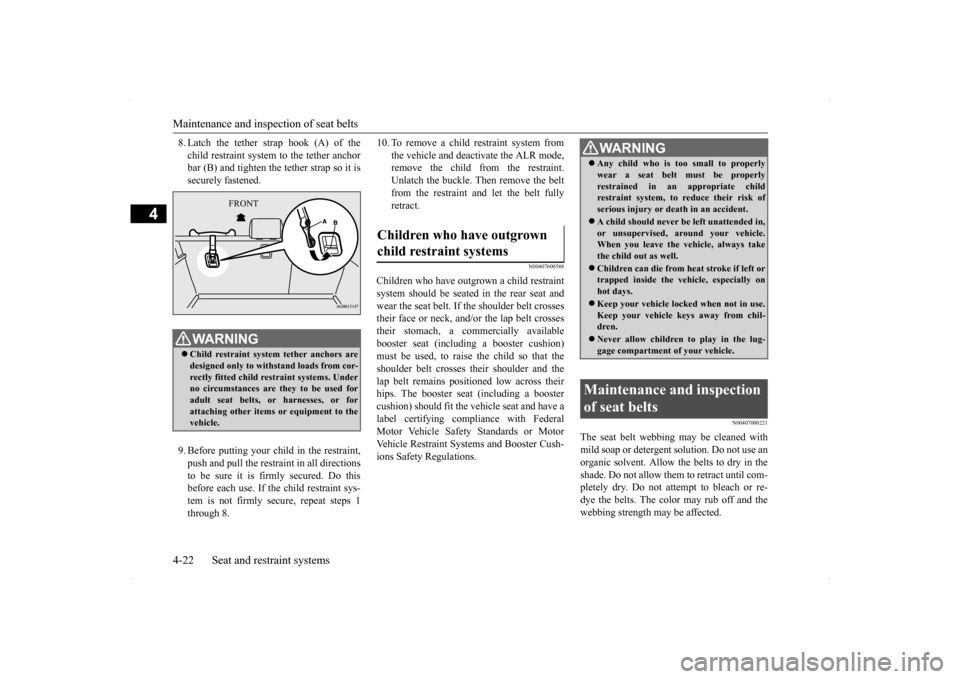
Maintenance and inspection of seat belts 4-22 Seat and restraint systems
4
8. Latch the tether strap hook (A) of the child restraint system to the tether anchor bar (B) and tighten the tether strap so it is securely fastened. 9. Before putting your child in the restraint, push and pull the restraint in all directionsto be sure it is firmly secured. Do this before each use. If the child restraint sys- tem is not firmly secure, repeat steps 1through 8.
10. To remove a child restraint system from
the vehicle and deactivate the ALR mode, remove the child from the restraint. Unlatch the buckle. Then remove the beltfrom the restraint and let the belt fully retract.
N00407600588
Children who have outgrown a child restraintsystem should be seated in the rear seat and wear the seat belt. If the shoulder belt crossestheir face or neck, and/or the lap belt crosses their stomach, a commercially available booster seat (including a booster cushion)must be used, to raise the child so that the shoulder belt crosses their shoulder and the lap belt remains positioned low across theirhips. The booster seat (including a booster cushion) should fit the vehicle seat and have a label certifying compliance with FederalMotor Vehicle Safety Standards or Motor Vehicle Restraint Systems and Booster Cush- ions Safety Regulations.
N00407000221
The seat belt webbing may be cleaned withmild soap or detergent solution. Do not use anorganic solvent. Allow the belts to dry in the shade. Do not allow them to retract until com- pletely dry. Do not attempt to bleach or re-dye the belts. The color may rub off and the webbing strength may be affected.
WA R N I N G Child restraint system tether anchors are designed only to withstand loads from cor- rectly fitted child restraint systems. Under no circumstances are they to be used foradult seat belts, or harnesses, or for attaching other items or equipment to the vehicle.
FRONT
Children who have outgrown child restraint systems
WA R N I N G Any child who is too small to properly wear a seat belt must be properly restrained in an appropriate child restraint system, to reduce their risk of serious injury or death in an accident. A child should never be left unattended in, or unsupervised, around your vehicle.When you leave the vehicle, always take the child out as well. Children can die from heat stroke if left or trapped inside the vehicle, especially on hot days. Keep your vehicle locked when not in use. Keep your vehicle keys away from chil-dren. Never allow children to play in the lug- gage compartment of your vehicle.
Maintenance and inspection of seat belts
BK0200700US.bo
ok 22 ページ 2013年2月15日 金曜日 午後12時17分
Page 50 of 422

Supplemental Restraint System (SRS) - airbag
Seat and restraint systems 4-23
4
Regularly check your seat belt buckles and their release mechanisms for positive engage- ment and release of the latch plate. Check the retractors for automatic locking when in theAutomatic Locking Retractor function. The entire seat belt assembly should be replaced if the webbing shows any obvious cuts, tears, increase in thickness in any sec-tion of the webbing from broken fibers, or severe fading from sunlight. All of these con- ditions indicate a weakening of the belt,which may adversely affect seat belt perfor-mance in an accident.
N00407701733
This vehicle is equipped with a SupplementalRestraint System (SRS), which includes air-bags for the driver and passengers.
The SRS front airbags are designed to supple- ment the primary protection of the driver and front passenger seat belt systems by provid- ing those occupants with protection againsthead and chest injuries in certain moderate to severe frontal collisions. The SRS front airbags, together with sensorsat the front of the vehicle and sensors attached to the front seats, form an advanced airbag system. The SRS driver’s knee airbag is designed to supplement the primary protection of thedriver’s seat belt system. It can reduce the forward movement of the driver’s lower legs and provide increased overall body protectionin certain moderate to severe frontal colli- sions. The SRS side airbags and the curtain airbags are also designed to supplement the seat belts.The SRS side airbags provide the driver and front passenger with protection against chest injuries by deploying the bag on the sideimpacted in moderate to severe side impact collisions. The SRS curtain airbags provide the driver and passengers on the front seatand rear outboard seat with protection against head injuries by deploying a bag on the side impacted in moderate to severe side impactcollisions.
The SRS airbags are NOT
a substitute for use
of the seat belts. For maximum protection in all types of accidents, seat belts must ALWAYS be worn by everyone who drives orrides in this vehicle (with infants and small children in an appropriate child restraint sys- tem in the rear seat, and older children buck-led in the rear seat). Refer to “Child restraint systems” on page 4-15.
WA R N I N G Do not attempt to repair or replace any part of the seat belt assemblies. This work should be done by an authorized Mitsubishi Motors dealer. Failure to havean authorized Mitsubishi Motors dealer perform the work could reduce the effec- tiveness of the belts and could result in aserious injury or death in an accident.
Supplemental Restraint Sys- tem (SRS) - airbag
WA R N I N G IT IS VERY IMPORTANT TO ALWAYS WEAR YOUR SEAT BELT PROPERLY EVEN WITH AN AIRBAG.• Seat belts help keep the driver and pas-sengers properly positioned. This reduces the risk of injury in all collisions,and reduces the risk of serious injuries or death when the airbags inflate. During sudden braking just before a col-lision, an unrestrained or improperly restrained driver or passengers can move forward into direct contact with, orwithin close proximity to, the airbag when it begins to inflate. The beginning stage of airbag inflation isthe most forceful and can cause serious injuries or death if the occupant comes in contact with the airbag at this time. • Seat belts reduce the risk of injury inrollovers, rear impact collisions, and in lower-speed frontal collisions, because the airbags are not designed to inflate inthose situations.
BK0200700US.bo
ok 23 ページ 2013年2月15日 金曜日 午後12時17分
Page 68 of 422
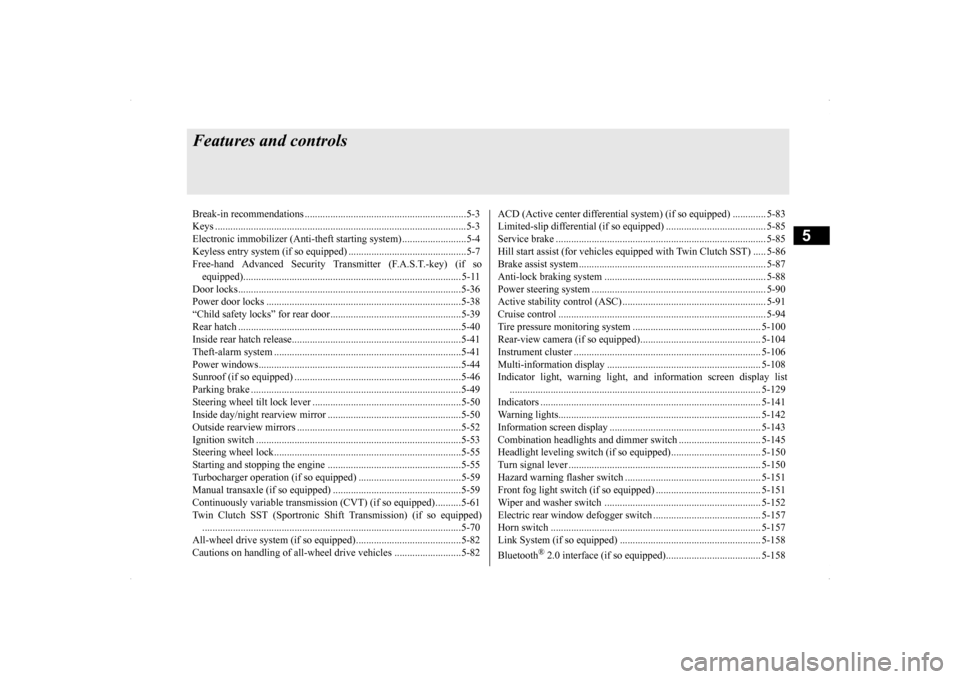
5
Features and controlsBreak-in recommendation
s ...............................................................5-3
Keys .....................................................
.............................................5-3
Electronic immobilizer (Anti-theft starting system) .........................5-4 Keyless entry system (if so equipped) ..............................................5-7Free-hand Advanced Security Transmitter (F.A.S.T.-key) (if so equipped)................................
..................................................... 5-11
Door locks........................
...............................................................5-36
Power door locks .............
...............................................................5-38
“Child safety locks” for
rear door...................................................5-39
Rear hatch ........................
...............................................................5-40
Inside rear hatch rel
ease................................
..................................5-41
Theft-alarm system ..........
...............................................................5-41
Power windows................
...............................................................5-44
Sunroof (if so equipped
) .........................................
........................5-46
Parking brake ...................
...............................................................5-49
Steering wheel tilt lock lever ..........................................................5-50Inside day/night rearview
mirror ....................................................5-50
Outside rearview mirr
ors ................................................................5-52
Ignition switch .................
...............................................................5-53
Steering wheel lock..........
...............................................................5-55
Starting and stopping the e
ngine ....................................................5-55
Turbocharger operation (if so equipped) ........................................5-59Manual transaxle (if so equipped) ..................................................5-59Continuously variable transmissi
on (CVT) (if so equipped)..........5-61
Twin Clutch SST (Sportronic Shif
t Transmission) (if so equipped)
...................................................................
..................................5-70
All-wheel drive system (if
so equipped).........................................5-82
Cautions on handling of all-wheel drive vehicles ..........................5-82
ACD (Active center differential system) (if so equipped) ............. 5-83 Limited-slip differential (i
f so equipped) ....................................... 5-85
Service brake ..................
.................................................
............... 5-85
Hill start assist (for vehicles equipped with Twin Clutch SST) ..... 5-86Brake assist system
................................................
......................... 5-87
Anti-lock braking syst
em ......................................
......................... 5-88
Power steering system
...........................................
......................... 5-90
Active stability control
(ASC) .....................
................................... 5-91
Cruise control .................
.................................................
............... 5-94
Tire pressure monitoring
system .................................................. 5-100
Rear-view camera (if so
equipped)..............
................................. 5-104
Instrument cluster .
.................................................
....................... 5-106
Multi-information disp
lay .....................................
....................... 5-108
Indicator light, warning light, and information screen display list
.................................................................
................................. 5-129
Indicators ..................................
.................................................... 5-141
Warning lights.................
.................................................
............. 5-142
Information screen disp
lay ....................................
....................... 5-143
Combination headlights and dimmer switch ................................ 5-145Headlight leveling switch (if
so equipped)................................... 5-150
Turn signal lever ...
.................................................
....................... 5-150
Hazard warning flasher
switch ..................................................... 5-151
Front fog light switch (if so
equipped) ......................................... 5-151
Wiper and washer swit
ch ......................................
....................... 5-152
Electric rear window def
ogger switch .......................................... 5-157
Horn switch ..............................
.................................................... 5-157
Link System (if so equi
pped) ....................................................... 5-158
Bluetooth
® 2.0 interface (if so
equipped)..................................... 5-158
BK0200700US.bo
ok 1 ページ 2013年2月15日 金曜日 午後12時17分
Page 103 of 422
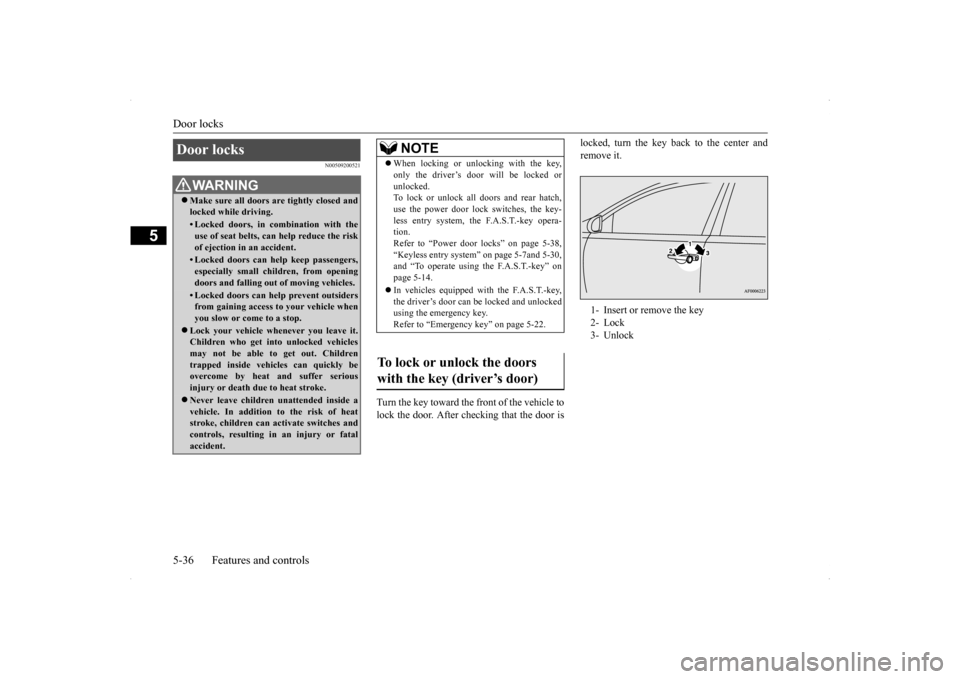
Door locks 5-36 Features and controls
5
N00509200521
Turn the key toward the front of the vehicle to lock the door. After checking that the door is
locked, turn the key back to the center and remove it.
Door locks
WA R N I N G Make sure all doors are tightly closed and locked while driving.• Locked doors, in combination with theuse of seat belts, can help reduce the risk of ejection in an accident.• Locked doors can help keep passengers,especially small chil
dren, from opening
doors and falling out of moving vehicles.• Locked doors can help prevent outsidersfrom gaining access to your vehicle whenyou slow or come to a stop.
Lock your vehicle whenever you leave it. Children who get into unlocked vehicles may not be able to get out. Children trapped inside vehicles can quickly beovercome by heat and suffer serious injury or death due to heat stroke. Never leave children unattended inside a vehicle. In addition to the risk of heat stroke, children can activate switches andcontrols, resulting in an injury or fatal accident.
NOTE
When locking or unlocking with the key, only the driver’s door will be locked or unlocked. To lock or unlock all doors and rear hatch, use the power door lock switches, the key-less entry system, the F.A.S.T.-key opera- tion. Refer to “Power door locks” on page 5-38,“Keyless entry system” on page 5-7and 5-30, and “To operate using the F.A.S.T.-key” on page 5-14. In vehicles equipped with the F.A.S.T.-key, the driver’s door can be locked and unlockedusing the emergency key. Refer to “Emergency key” on page 5-22.
To lock or unlock the doors with the key (driver’s door)
1- Insert or remove the key 2- Lock 3- Unlock
BK0200700US.bo
ok 36 ページ 2013年2月15日 金曜日 午後12時17分
Page 106 of 422
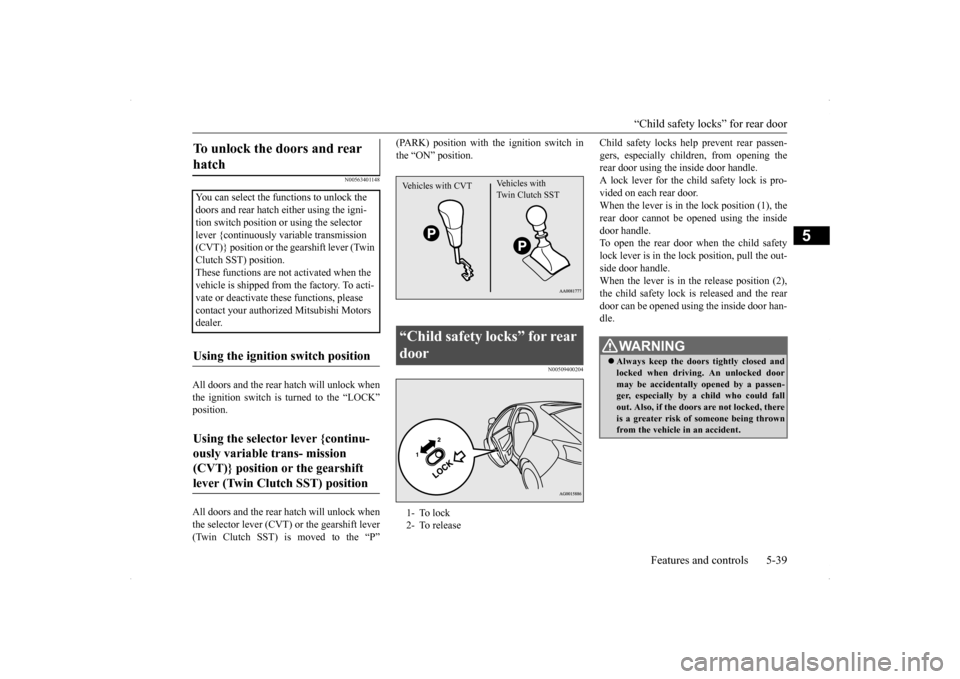
“Child safety locks” for rear door
Features and controls 5-39
5
N00563401148
All doors and the rear hatch will unlock when the ignition switch is turned to the “LOCK” position. All doors and the rear hatch will unlock when the selector lever (CVT) or the gearshift lever(Twin Clutch SST) is moved to the “P”
(PARK) position with the ignition switch in the “ON” position.
N00509400204
Child safety locks help prevent rear passen-gers, especially children, from opening the rear door using the inside door handle. A lock lever for the chil
d safety lock is pro-
vided on each rear door. When the lever is in the lock position (1), the rear door cannot be opened using the insidedoor handle. To open the rear door when the child safety lock lever is in the lock position, pull the out-side door handle.When the lever is in th
e release position (2),
the child safety lock is released and the rear door can be opened using the inside door han-dle.
To unlock the doors and rear hatch You can select the functions to unlock the doors and rear hatch either using the igni- tion switch position or using the selector lever {continuously variable transmission (CVT)} position or the gearshift lever (Twin Clutch SST) position.These functions are not activated when the vehicle is shipped from the factory. To acti- vate or deactivate these functions, please contact your authorized Mitsubishi Motors dealer.Using the ignition switch position Using the selector lever {continu- ously variable trans- mission (CVT)} position or the gearshift lever (Twin Clutch SST) position
“Child safety locks” for rear door 1- To lock 2- To releaseVehicles with CVT
Vehicles with Twin Clutch SST
WA R N I N G Always keep the doors tightly closed and locked when driving. An unlocked door may be accidentally opened by a passen- ger, especially by a child who could fallout. Also, if the doors are not locked, there is a greater risk of someone being thrown from the vehicle in an accident.
BK0200700US.bo
ok 39 ページ 2013年2月15日 金曜日 午後12時17分
Page 111 of 422
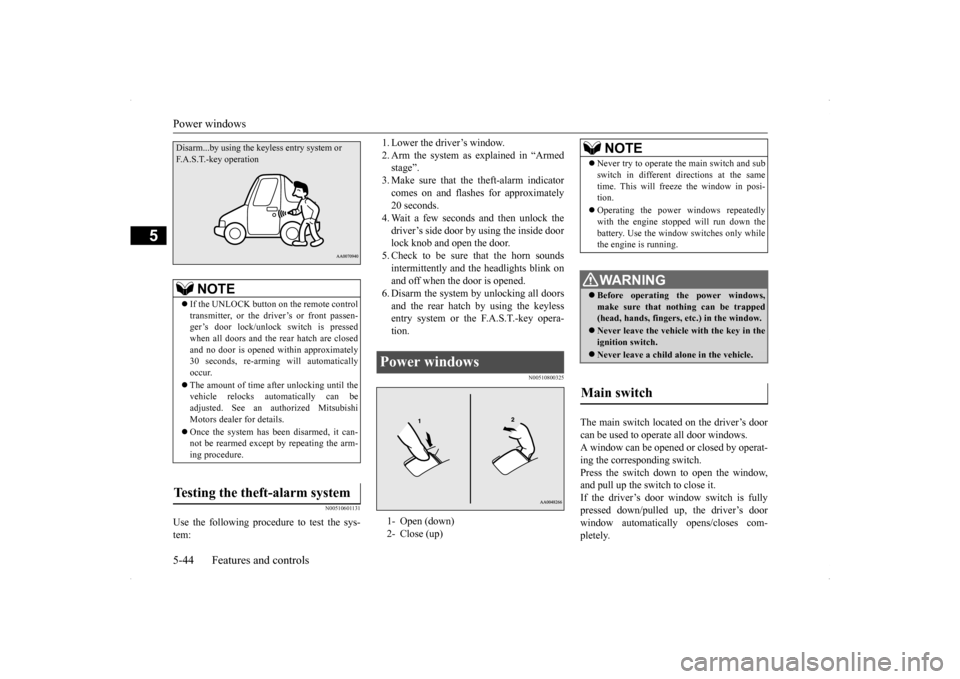
Power windows 5-44 Features and controls
5
N00510601131
Use the following procedure to test the sys- tem:
1. Lower the driver’s window. 2. Arm the system as explained in “Armed stage”. 3. Make sure that the theft-alarm indicatorcomes on and flashes for approximately 20 seconds. 4. Wait a few seconds and then unlock thedriver’s side door by using the inside door lock knob and open the door. 5. Check to be sure that the horn soundsintermittently and the headlights blink onand off when the door is opened. 6. Disarm the system by unlocking all doors and the rear hatch by using the keylessentry system or the F.A.S.T.-key opera- tion.
N00510800325
The main switch located on the driver’s door can be used to operate all door windows. A window can be opened or closed by operat- ing the corresponding switch.Press the switch down to open the window, and pull up the switch to close it. If the driver’s door window switch is fullypressed down/pulled up, the driver’s door window automatically opens/closes com- pletely.
NOTE
If the UNLOCK button on the remote control transmitter, or the driver’s or front passen- ger’s door lock/unlock switch is pressedwhen all doors and the rear hatch are closed and no door is opened
within approximately
30 seconds, re-arming will automaticallyoccur. The amount of time after unlocking until the vehicle relocks automatically can be adjusted. See an authorized Mitsubishi Motors dealer for details. Once the system has been disarmed, it can- not be rearmed except by repeating the arm-ing procedure.
Testing the theft-alarm system Disarm...by using the ke
yless entry system or
F.A.S.T.-key operation
Power windows 1- Open (down) 2- Close (up)
NOTE
Never try to operate the main switch and sub switch in different directions at the same time. This will freeze the window in posi- tion. Operating the power windows repeatedly with the engine stopped will run down the battery. Use the window switches only whilethe engine is running. WA R N I N G Before operating the power windows, make sure that nothing can be trapped(head, hands, fingers, etc.) in the window. Never leave the vehicle with the key in the ignition switch. Never leave a child alone in the vehicle.
Main switch
BK0200700US.bo
ok 44 ページ 2013年2月15日 金曜日 午後12時17分
Page 113 of 422

Sunroof (if so equipped) 5-46 Features and controls
5
N00549000127
When this switch is in the lock mode, the main switch for passenger door window and the sub switch cannot be used to open orclose the door window, and the main switch
will open or close only the driver’s door win- dow. To unlock the switch, press it again.
N00551400014
Wind buffeting can be described as the per- ception of pressure on the ears or a booming or rumbling sound. Your vehicle may exhibitwind buffeting when driving with one or both
rear door windows down or partially opened. This is a normal occurrence that can be mini- mized. If the buffeting occurs with the rear door windows open, open the front door win-dows as well as the rear door windows to minimize the condition.
N00511000669
The sunroof can be opened and closed with the ignition switch in the “ON” position.
NOTE
The safety mechanism can be activated if the driving conditions or other circumstances cause the door window to be subjected to a physical shock similar to that caused by trapped hand or head. If the safety mechanism is activated 3 or more times consecutively, the safety mecha-nism is deactivated and normal closing of the door window will be aborted. Use the following method to return to normaloperation. 1. If the door window is open, repeatedly pull up the power window switch to fully close the door window. 2. With fully closing the window, releasethe switch and then pull up the switch again for about 1 second.
Lock switch
1- Lock 2- UnlockWA R N I N G Before driving with a child in the vehicle, be sure to lock the window switch to makeit inoperative. Children tampering with the switch could easily trap their hands or heads in the window.
What to do if you hear wind buffeting when driving
Sunroof
(if so equipped)
WA R N I N G Do not stick your head, hands or anything else in the sunroof opening. Before operating the sunroof, make sure that nothing can be trapped (head, hands, fingers, etc.). Never leave a child (or other person who is incapable of safely operating the sunroof switch) alone in the vehicle.
BK0200700US.bo
ok 46 ページ 2013年2月15日 金曜日 午後12時17分
Page 262 of 422
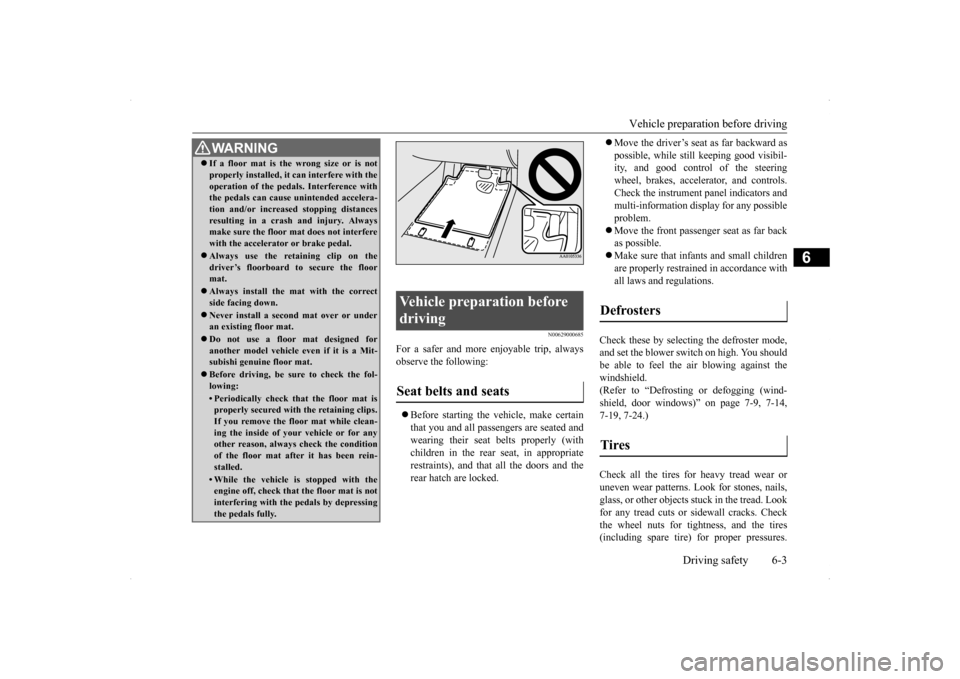
Vehicle preparation before driving
Driving safety 6-3
6
N00629000685
For a safer and more enjoyable trip, always observe the following: Before starting the vehicle, make certain that you and all passengers are seated and wearing their seat belts properly (with children in the rear seat, in appropriaterestraints), and that all the doors and the rear hatch are locked.
Move the driver’s seat as far backward as possible, while still keeping good visibil- ity, and good control of the steering wheel, brakes, accelerator, and controls.Check the instrument panel indicators and multi-information display for any possible problem. Move the front passenger seat as far back as possible. Make sure that infants and small children are properly restrained in accordance withall laws and regulations.
Check these by selecting the defroster mode, and set the blower switch on high. You should be able to feel the air blowing against the windshield.(Refer to “Defrosting or defogging (wind- shield, door windows)” on page 7-9, 7-14, 7-19, 7-24.) Check all the tires for heavy tread wear or uneven wear patterns. Look for stones, nails,glass, or other objects stuck in the tread. Look for any tread cuts or sidewall cracks. Check the wheel nuts for tightness, and the tires(including spare tire) for proper pressures.
WA R N I N G If a floor mat is the wrong size or is not properly installed, it can interfere with the operation of the pedals. Interference with the pedals can cause unintended accelera- tion and/or increased stopping distancesresulting in a crash and injury. Always make sure the floor mat does not interfere with the accelerator or brake pedal. Always use the retaining clip on the driver’s floorboard to secure the floormat. Always install the mat with the correct side facing down. Never install a second mat over or under an existing floor mat. Do not use a floor mat designed for another model vehicle ev
en if it is a Mit-
subishi genuine floor mat. Before driving, be sure to check the fol- lowing:• Periodically check that the floor mat isproperly secured with the retaining clips. If you remove the floor mat while clean-ing the inside of your vehicle or for any other reason, always check the condition of the floor mat after it has been rein-stalled.• While the vehicle is stopped with the engine off, check that the floor mat is not interfering with the pedals by depressingthe pedals fully.
Vehicle preparation before driving Seat belts and seats
Defrosters Tires
BK0200700US.bo
ok 3 ページ 2013年2月15日 金曜日 午後12時17分